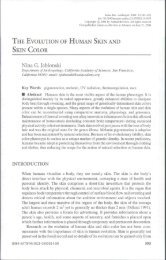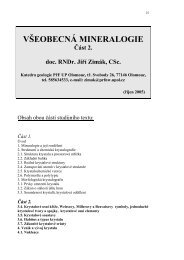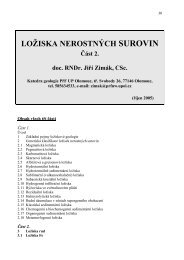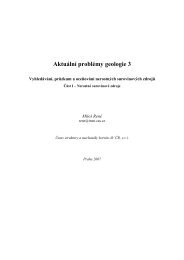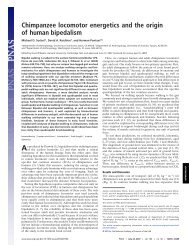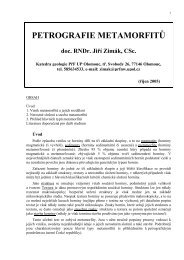Esej o Habilinovi http://www.becominghuman.org/node/homo ...
Esej o Habilinovi http://www.becominghuman.org/node/homo ...
Esej o Habilinovi http://www.becominghuman.org/node/homo ...
You also want an ePaper? Increase the reach of your titles
YUMPU automatically turns print PDFs into web optimized ePapers that Google loves.
Because of the range of variation present in early Homo fossils, there has been controversy over<br />
whether H. habilis should be considered one highly variable, sexually dimorphic (exhibiting large size<br />
differences between the sexes) species, or whether some specimens originally grouped with H.<br />
habilis should be separated into a different species, Homo rudolfensis (see essay on H. rudolfensis for<br />
more detailed information on this controversy). However, critical examination of the fossil anatomy<br />
of these specimens reveals that the patterns of variation expected in a sexually dimorphic species are<br />
not present among H. habilis and H. rudolfensis fossils. Furthermore, dental analysis suggests that<br />
each species had very different ecological niches. At present, it is generally accepted that H. habilis<br />
and H. rudolfensis represent separate species.<br />
The first H. habilis fossils were found in Olduvai G<strong>org</strong>e in the same stratigraphic layer as early types<br />
of stone tools called Oldowan tools. These tools are very simple, and comprise a core, the scarred<br />
center of rock that results from the detachment of one or more flakes (the portion of rock removed<br />
from original source material by percussion or pressure) from a lump of source material. These<br />
cores, while simple, had sharp, cutting edges, and could be used for many purposes. Although H.<br />
habilis fossils are found near stone tools, they are not the only hominins to be linked to tool<br />
manufacture. For example, Paranthropus boisei fossils have also been found near stone tools,<br />
making definitive determination of which species was a tool-maker impossible. (There were several<br />
different species, Australopithecus, Parantropus and Homo, extant between 2.5 and 2.0 mya, as can<br />
be seen on the Timeline graphic.) Because H. habilis has a larger brain and smaller teeth than other<br />
australopiths (including P. boisei), many scientists consider them to be the earliest tool-makers.<br />
However, this assertion may need to be re-evaluated in light of more recent finds of a species of<br />
australopith, Australopithecus garhi, with a smaller brain and larger teeth than H. habilis, and that is<br />
associated with stone tools (see essay on A. garhi for more information).<br />
Speculations as to whether Australopithecus or Homo was the first user of stone tools may have<br />
been made moot by the discovery in 2009 of markings on animal bones which could have been made<br />
only by stone being used to deflesh the bones. The bones bearing stone cut marks were found at<br />
Dikika, Ethiopia and dated to 3.4 ma, a time at which the only hominin then extant was<br />
Australopithecus afarensis.<br />
About 2.5 mya, Africa underwent a climatic change that resulted in the changing of hominin habitats<br />
from more closed and wet to more open and arid, which lead to changes in available food resources<br />
and may have signaled the origins of the genera Homo and Paranthropus. By approximately 2 mya,<br />
however, the climate was returning to slightly more warm and humid conditions. Environmental<br />
reconstructions of H. habilis sites suggest that these hominins lived in a woodland habitat with access<br />
to lakes and/or streams.<br />
H. habilis is one of the oldest species in the genus Homo. Nevertheless, evidence suggests that in<br />
some ways, it was quite similar to species in the genus Australopithecus, especially in aspects of the




